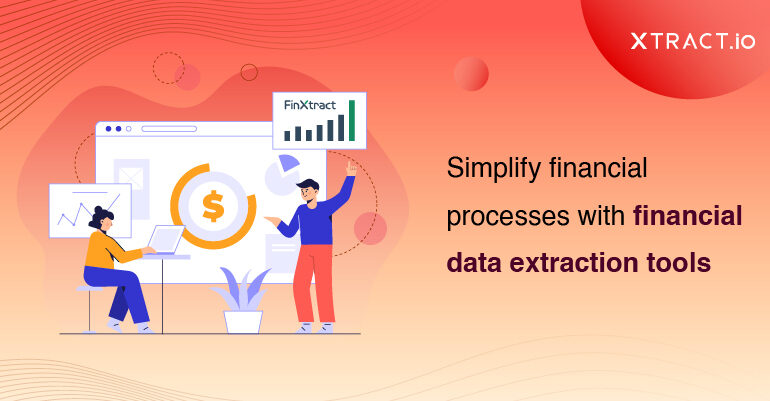What is financial data extraction?
Financial data extraction is the process of extracting financial data from unstructured or semi-structured sources. This process is tedious and time-consuming compared to extracting data from structured sources, as they are innately machine-readable.
Meaningful insights derived from this extracted data are employed to make critical financial and business decisions.
Data challenges for financial services
Financial teams face several data challenges due to the increase in the unstructured data that needs processing. Let’s take a closer look at these challenges and learn how to overcome them.
Extracting data from disparate sources
Imagine the financial ecosystem within a huge corporation. There are several sources from which financial data flows — balance sheets, invoices, cash flow statements, etc. These documents come in different and in unstructured or semi-structured formats. The financial team needs to extract and collate the data from these sources and develop insightful reports for decision-making.
Ensuring high data quality
Though data is the new oil, it is available like water. Data is everywhere, but it is up to us to get a constant flow of high-quality data into our stream. Financial analysts and hedge fund managers are now looking for alternative data sources to help their business other than internal company data. These external data must undergo quality checks to avoid missteps or loss of time during the decision-making process.
Handling large volumes of data
It’s pretty clear that data is available in massive volumes and keeps growing every second. Similarly, the amount of financial data processed every year is only increasing. This increase in workload is the main reason why process automation is crucial. Manually extracting and analyzing massive volumes of data is not considered smart work as it is time-consuming, expensive, and prone to errors.
Adhering to regulatory requirements
In today’s world, even a medium-sized organization operates from multiple global locations. The financial data and reports of each of these office branches should match the regulatory compliance of their region. This can be painstaking, as you should be up-to-date on these countries’ frequently changing regulatory norms.
Integrating data into various software
Tableau, SAP, CRM, and ERP are some commonly used software in companies that need a periodic inflow of processed financial data. Manual extraction means your finance team should also manually input the data into each software delaying access to the data. This leads the software to work with historical data instead of real-time data.
How does the financial data extraction tool work?
Technology has given us the solution for most of our business (and life) problems. So, it’s no surprise that the challenges mentioned above can be resolved using a financial data extraction tool that simplifies the whole process.
The financial data extraction tools use Artificial Intelligence(AI) & Natural Language Processing (NLP) to extract data from disparate sources. As a subset of these technologies, deep learning and computer vision are used to improve process efficiency.
Typically a financial data extraction tool performs the following steps,
Extraction
Financial data extraction tools use taxonomy mapping and ML models to identify data fields, process semi-structured documents, extract the desired data, and present it in an easily digestible format. Now, you can also quickly extract data in batches (i.e., for specific periods) or in real-time.
Evaluation
The quality of the extracted data is evaluated using the human-in-the-loop feedback mechanism of the financial data extraction tools. Further, these tools ensure that the financial data follows all the regulatory and compliance requirements.
Integration
You can seamlessly integrate financial data extraction tools into your existing software (cloud-based or not), which will ensure a continuous flow of high-quality financial data into them. This integration will tremendously improve the time-to-insights, in turn accelerating business decisions.
Observation
Once your extraction process is complete, the tool provides you with a quality report that evaluates the extraction process’s efficiency. It contains:
- Available attributes – These are attributes typically available in any industry financial report.
- Good – The number of attributes in your documents that have correct values specified.
- Bad – The number of attributes in your document that have the wrong values.
- Not present – The number of attributes in your document that do not have any values mentioned.
- Coverage – This specifies the coverage ratio for this process which is the number of attributes extracted / total number of attributes.
- Accuracy – This evaluates the number of attributes that have been correctly extracted.
This quality report is followed by the root cause analysis and coverage report, which helps understand where the process can be improved next time.
Conclusion
Data extraction from financial reports is the first and most important step in budget and business strategy meetings. Though a critical activity, it is unnecessary to spend a lot of time and manpower on it. The financial data extraction tool has already become widely popular, and its myriad of benefits will only make financial teams wonder what they will do without it.
If you are impressed by what this tool can do, you should check out one of the best financial data extraction tools in the market, FinXtract. Contact us to connect with our solutions expert and understand how it can be hyper-customized to suit your requirements.








1 Comment
Hello Suparna, thank you for sharing this grate content for financial data extraction. It can save time and reduce errors, which is crucial in a fast-paced industry like ours.